Lisbon - Accessible Tour
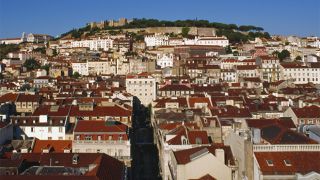
Known as the ‘City of the Seven Hills’, Lisbon is increasingly becoming a more accessible city by removing architectural and uneven barriers. The introduction of new paving, ramps and appropriate signposting has created conditions facilitating the movement of people with difficulties in mobility, and made it possible for everyone to enjoy public spaces, enabling them to move around independently.
We recommend three tours to get to know the most iconic areas independently: Belém, a massive area which was once the port from which ships and caravels left for the epic sea voyages of Discovery; take a walk from Bairro Alto to the Castelo de São Jorge (São Jorge Castle), the nerve centre of Lisbon where there is a lot of entertainment on offer; then, continue to the Parque das Nações (Park of the Nations), a modern space reclassified for the 1998 World Fair to celebrate the feats of the great Portuguese explorers of the 16th century.
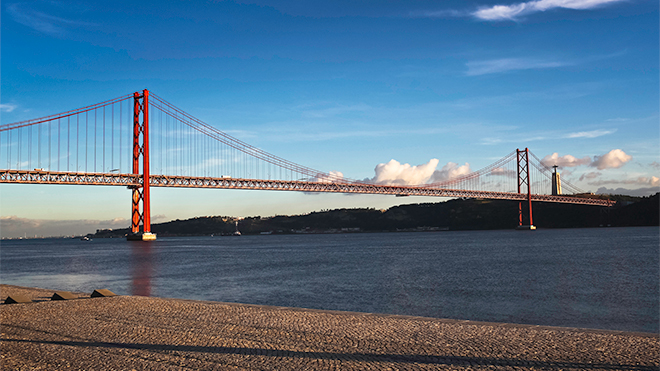
Photo: Ponte 25 de Abril - Lisboa © Turismo de Lisboa
To follow these tours, visit the links (above this text), where you will find information on each of them and maps which will help you during your visit.
To move around between different areas, there is a network of public transport, guaranteeing connections in the area. In the city, Carris is a company that operates buses and trams, and has adapted vehicles, such as the Metro. However, not all its stations are accessible. In CP trains, in some of the connecting train stations, it is possible to move around independently, but in others you need to request assistance in advance. Taxi transport is an option you can consider as there are several taxi companies which have adapted vehicles. For more details on public transport in Lisbon, click on the link ‘Useful Information’.

In the 15th and 16th centuries, ships and caravels left Belém to discover distant lands on other continents. Witnesses of this period are two monuments which you can visit and which are classified by UNESCO as World Heritage sites - the Jerónimos Monastery and the Tower of Belém. But, there is very much more to know in this area with gardens on the river bank, where it is very pleasant to have a walk.
Download the map and follow the tour
Belém is a flat area with regular paving which is generally in good condition. So, it enables everyone to move around more easily and safely. We recommend that you start your tour at the Museu dos Coches (Coach Museum) (10), which contains the world’s most unique collection housed in a recently built and totally accessible building.
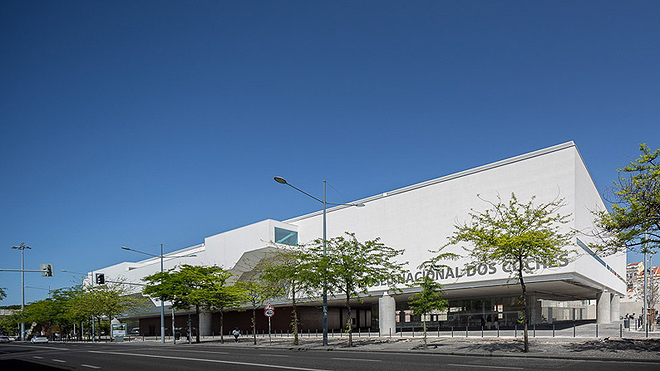
Photo © Museu Nacional dos Coches
The tour continues along Rua de Belém where visitors need to walk carefully, especially along paved surfaces of crossings where a little wear and tear in some places, for example where there are tramway lines, make secure movement difficult. Along the walks, there are obstacles because of the many shops and restaurants in the area. This may require you to move onto roads that are destined for vehicular traffic. Most of these commercial spaces do not have accessible entrances. However, many of the restaurants have terraces in the pedestrianised area overlooking the Gardens (Jardim) - an excellent option for meals. Crossings, which are generally low, have a few uneven spots of two or three centimetres, which may require extra effort.
The Jardim Botânico Tropical (Tropical Botanical Gardens) (7), one of the largest green spaces in the city, is the next point on our tour before proceeding to the Mosteiro dos Jerónimos (Jerónimos Monastery) (6), located on the other side of the street. This very beautiful monument, the best example of the Manueline architectural style, enables everyone to take full advantage of the visit by providing tactile routes, information in Braille and audio support equipment. Moving around on the ground floor is facilitated by wide spaces, without obstacles, making the most emblematic spaces, like the Church and the Cloister, easier to visit. Located at the western end of this building, the Museu de Marinha (Maritime Museum) (5) offers similar conditions enabling everyone to see its collection which includes many nautical instruments and replicas of caravel of the age of the Discoveries.

Photo: Praça do Império - Mosteiro dos Jerónimos © Arquivo Turismo de Portugal
At the Praça do Império (Empire Square) (8), we recommend a walk around the garden which has regular paving, in tar and beaten earth, but there is a pronounced unevenness in some areas. Its trademark is the impressive fountain which is lit up in different colours at night. Also in this square, it is worth visiting the Centro Cultural de Belém (the Belém Cultural Centre) (4), which stands out for its modernity as being a fully accessible space, which houses the Contemporary Art Museum, various terraces and a vast programme of shows and exhibitions.
The tour continues on the other side of the train line, but as there are no accessible crossings between Avenida da Índia and Avenida Brasília, closer to the river (they all have stairs), it is necessary to find other means of transport to continue the tour.
On the other side of the train line, you can visit the Museu do Combatente (1), which is endowed with wide spaces where it is easier to move around, except along the walls and the upper floors where access is by a staircase. In the immediate surroundings, there is the vast Jardim da Torre de Belém (Belém Tower Gardens) (3). It is a leisure space that is greatly valued, where you can find a model of the tower itself, a world heritage site, with a description of it in Braille for everyone to know more about it. However, because of its architecture, access is difficult of people with reduced mobility. 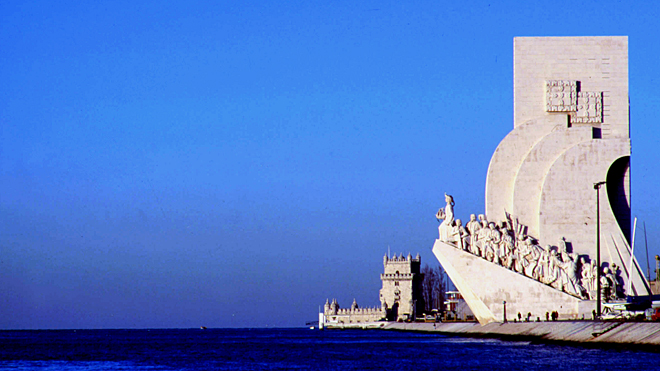
Photo: Padrão dos Descobrimentos - Torre de Belém © Arquivo Turismo de Portugal
The Padrão dos Descobrimentos (the Monument to the Discoveries) (9), another main attraction in this area, is inaccessible for wheelchair users owing to the stairs at the entrance and access to the terrace. It is always possible, however, to view the sculptures adorning both sides of the monument, which pay homage to the great explorers of the 15th and 16th centuries. Their sea routes are immortalised in the enormous ‘Rosa-dos-Ventos ‘ (the Compass Rose), designed in stone on the ground.
The last visit on this tour is MAAT – Museu de Arte, Arquitetura e Tecnologia (Museum of Art, Architecture and Technology) (11), at the former Tagus Power Station which supplied electricity for the whole city of Lisbon in the first half of the 20th century. It is framed by more uneven paving, requiring visitors to move around more carefully. Inside the Museum, the space is fully accessible for people with reduced mobility. There, visitors may see temporary exhibitions put on among the vast calendar of activities, as well as the structure of the buildings.
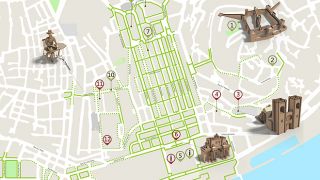
Download the map and follow the tour
To get to know the heart of Lisbon, we recommend a tour which leads from Bairro Alto to the Castelo de São Jorge (São Jorge Castle), via Baixa Pombalina (Pombaline Downtown), an area full of shops and restaurants. The starting point is the Largo de Camões (Camões Square). However, before starting the tour, we must mention some of the places surrounding the square, which may be a pretext for future visits. For example, if you go up Rua da Misericórdia, you will find the Igreja and Museu de São Roque (São Roque Church and Museum), which houses true treasures of Sacred Art. Opposite the end of Rua do Alecrim, there is the Cais do Sodré (Sodré Piers), where you can find other options such as a walk on the Ribeira das Naus, a very pleasant walk along the riverbank to Terreiro do Paço (or Praça do Comércio) with terraces and leisure spaces; the Ribeira Market which was remodelled to incorporate a very busy restaurant and leisure area; and at a short distance away, the Museu das Comunicações (Museum of Communication) (14), all accessible for people with reduced mobility. At the Cais do Sodré, there is the train station from which trains leave for Cascais, a journey with beautiful views of the Tagus river and the sea.
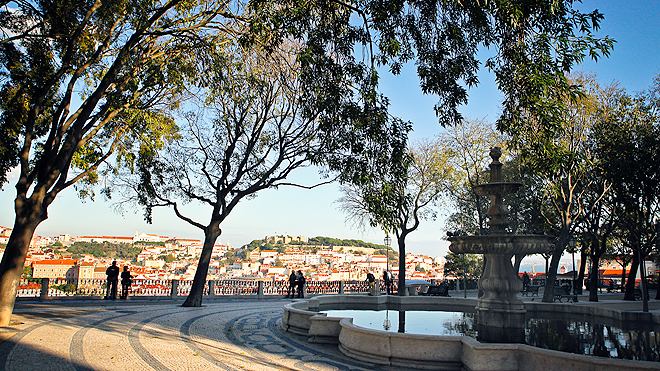
Photo: Miradouro de São Pedro de Alcântara © Turismo de Lisboa
Returning to the starting point of this tour, from the Largo de Camões, dominated by the statue of the great Portuguese poet, the tour continues along Rua Garrett, where you will certainly feel restored in the two churches standing facing each other - Loreto Church and Sacramento Church, access to which is by stairs, which makes the visit difficult. Further on, you will certainly want to stop to take a photo of the table in the terrace of the Café A Brasileira, near the statue of Fernando Pessoa. To the right, on Rua de Serpa Pinto, there is the Museu Nacional de Arte Contemporânea (National Museum of Contemporary Art (12), which presents a complete retrospective view of Portuguese artistic development. Like the Museum, all these routes are fully accessible, but the steep slope of the streets can make it difficult to walk easily.
Further down, there is the Igreja dos Mártires (Church of the Martyrs) (11), where the steps at the entrance render it inaccessible for wheelchair users. The same applies to some of the many restaurants and shops which make up Rua Garrett and Rua do Carmo. At Rossio (8), flat surfaces, regular paving and low walkways facilitate movement, allowing visitors to enjoy the fountains fully. The facade of the Teatro Nacional D. Maria II (D. Maria II National Theatre) and the pavement in Portuguese paving stone with their motif of the ‘high sea’ create the optical illusion of waves. Nearby are the Igreja de São Domingos (Santo Domingo Church) (9) and the Praça da Figueira which are two fully accessible spaces.

Photo: Rossio © José Manuel
The tour continues along Rua Augusta (7), which is fully pedestrianised and accessible, with its only obstacle being the terraces at the centre. You may prefer to move along the sides without any difficulties. At the end of this route is the Arco da Rua Augusta (Rua Augusta Arch) (6). You can visit it, although to enter the terrace and enjoy the view, you have to go up the narrow staircase, making it inaccessible for people with reduced mobility. Alternatively, you can enjoy walking along the even surfaces of the Praça do Comércio (5) which overlooks the Tagus River and is considered one of most beautiful plazas in Europe. Enjoy the space under the arcades where there are various restaurants and terraces for a relaxing meal. Don’t miss the Lisboa Story Center. It is a place where you can find out about the history of the city using interactive media in a fully adapted building that also houses the Tourist Office, which provides facilities guaranteeing inclusivity. 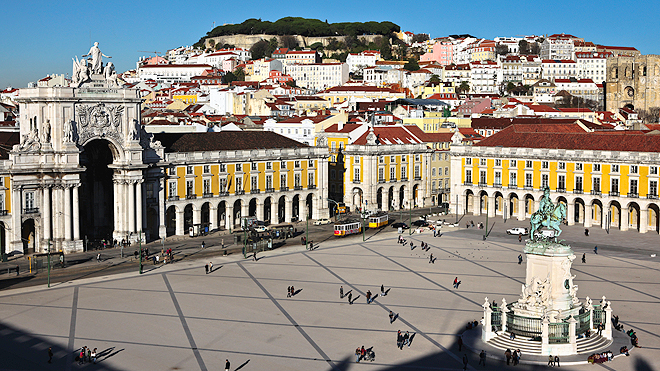
Photo: Praça do Comércio © Turismo de Lisboa
The last visit on this tour is the Castelo de São Jorge (São Jorge Castle) (1). From Baixa, there is public transport which can take you to the top, but by small buses or trams which have high steps. Consequently, they are inaccessible for people with reduced mobility. The most common tour follows the tram line from the Rua da Conceição which involves walking up steep roads which include various points of interest such as the Igreja da Madalena (Magdalena Church) (4) where the steps at the entrance and obstacles in the church make the visit difficult. A little higher up is the Cathedral (3), of Romanesque origin, which also has steps at the entrance. However, the interior is wide, without obstacles. Higher up, there are two vantage points which offers spendid views of the city, which all can enjoy without difficulties in accessibility – the Miradouro de Santa Luzia (6) and the Miradouro das Portas do Sol. From here to get back to the Castle, you have go down the steep and winding streets of the Alfama, which is difficult. This tour is not easy for people with difficulties in mobility. If they wish to follow this tour, it is better for them to do it in an adapted vehicle.
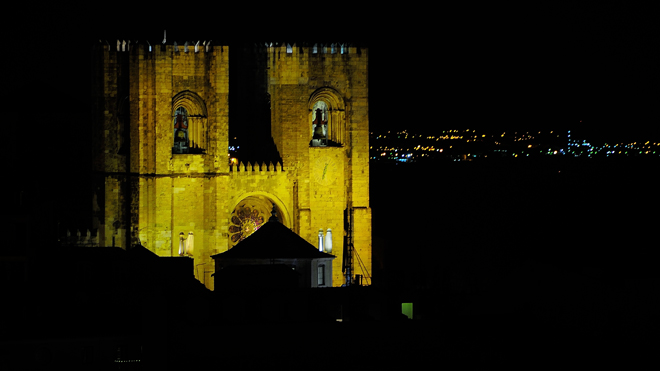
Photo: Sé de Lisboa © Turismo de Portugal | RR
There is, however, a way of getting to the Castle independently, by using lifts from building No. 170/178 on Rua dos Fanqueiros, which are fully accessible for people with reduced mobility. The first lift goes up to Largo Adelino Amaro da Costa, where the only difficulty will be to cross the wide open space which has no guiding lines to the entrance of the second lift near the Mercado do Chão de Loureiro. When you leave the lift, you come across another vantage point where it is worth stopping to enjoy the panoramic view over the city before continuing the rest of the tour that is around 500 metres up to the walls, a route with inclines and uneven paving, which can make moving around difficult.
Entrance into the Castelo de São Jorge (1) is by ramp – a lot easier than the entrance encountered by the Christians, led by Afonso Henriques, the first King of Portugal, in the 12th century when they defeated the Muslims. Inside, the wide space, with few obstacles, enables everyone to get to know this monument, which was witness to the long history of Portugal, and enjoy the best views over Lisbon.

The Parque das Nações is an area next to the Tagus River which was completely renovated for the 1998 World Fair. It is flat with wide open spaces, even paving and many pedestrianised areas, enabling safe and comfortable movement. This is one of more modern areas of the city, identified globally as an example of urban rehabilitation, with various buildings undersigned by prestigious architects in contemporary architecture.
Download the map and follow the tour
The tour we are recommending here starts at the Estação do Oriente, designed by Spanish architect Santiago Calatrava. In addition to being a platform for intermodal transport and a fully accessible space, it is a work of great beauty in which you can admire the complex structure with vertical lines reminiscent of gothic arches.

Photo: Parque das Nações © Arquivo Turismo de Portugal
From here, our tour crosses Avenida Dom João II and continues along Avenida do Índico up to the Alameda dos Oceanos, an avenue of around two km long which crosses the Parque das Nações from one end to the other. Here and there, there are several areas providing rest when you need it, with trees, benches and jets of water which ‘erupt’ over little lakes and cool down the atmosphere in summer. The level paving has some raised unevenness. Visitors also need to watch out for props (bollards), which prevent parking, and hollows around trees may prove to be unexpected obstacles.
When we arrive this Alameda, you will certainly note several eye-catching buildings, of which two attract more people to this area. Inside, they are fully accessible. Opposite, there is the MEO Arena (5), also known as the Pavilhão Atlântico (Atlantic Pavillion), a structure which is reminiscent of the extraterrestrial ship (UFO). This is one of the major venues for events in Lisbon: concerts and shows by internationally renowned artists. Then on the left, there is the Feira Internacional de Lisboa (Lisbon International Exhibition Centre) (7) which holds various fairs and trade exhibitions.
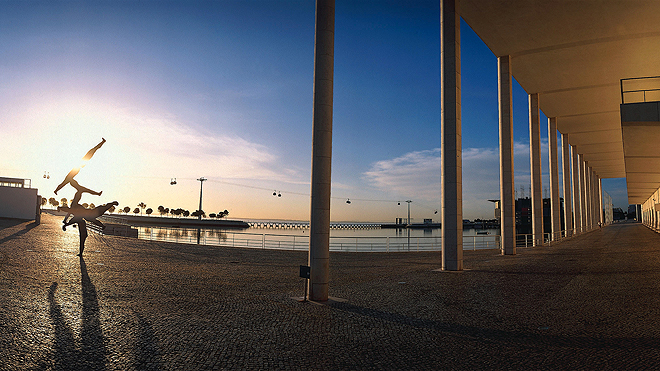
Photo: Parque das Nações - Pavilhão de Portugal © Arquivo Turismo de Portugal
To the right is the Pavilhão de Portugal (Pavillion of Portugal) in which the crowning glory is the renowned work of architecture and engineering by two of the great names of Portuguese architecture - Siza Vieira e Souto de Moura. A little further on, in the centre of the Doca dos Olivais (Olivais Docks), there is the Oceanarium (4), one of the largest in Europe, where the marine environments of various continents are so accurately portrayed that we almost feel as if we are on a voyage. Built with people with special requirements in mind, it is a fully accessible and adapted building, with audio equipment available in several languages and assistants to support visits, as well as an area providing tactile experience. Also, not to be missed is the walkway over the Olivais Docks which offers a panoramic view over the river and the Parque das Nações. However, visitors need to walk carefully since the surface is uneven on the wooden planks.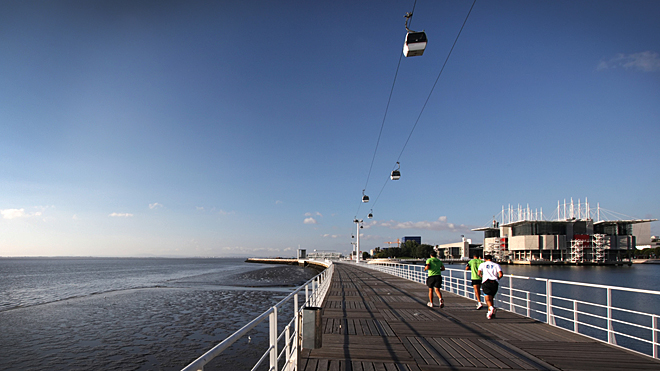
Parque das Nações - Oceanário © Turismo de Lisboa
Close by, the Pavilhão do Conhecimento (Pavillion of Knowledge) (3), is an interactive museum of Science and Technology, the interior of which is wide and without obstacles. It is accessible to all, with information available in Braille, and assistants who can communicate in sign language. Other public spacias that are classified as ‘Accessible’ and worth visiting are the Marina Parque das Nações (the Parque das Nações Marina) (1) and the Camões Theatre, the headquarters of the National Ballet Company. There is a full calendar of shows put on throughout the year. 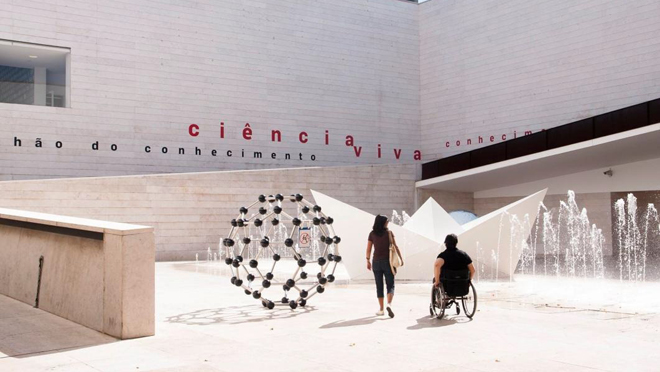
Photo: Pavilhão do Conhecimento © Paula Teles
To highlight a few more gardens, there are the Jardins da Água (Water Gardens) (2), a tour of which involves some obstacles; the Passeio das Tágides (6) and the Jardins Garcia d’Orta, with exotic flora from foreign lands on other continents, discovered by Portuguese explorers during the great epic period of the 15th and 16th centuries.
For a panoramic view over the city and of the Tagus River, there is nothing like a ride in the cable car (teleférico), which is fully adapted with four cabins to accommodate people with special requirements. The two stations, which are also fully accessible, are to the south of Passeio de Neptuno, near the Lisbon Oceanarium, and north of Passeio das Tágides, next to the Myriad Hotel.
Buses and Trams
Carris - the Lisbon Public Transport has buses that have been adapted for people with reduced mobility, equipped with access ramps, platform lifts (in the latest buses), wide interior spaces, reserved places, audible and luminous alerts, and Braille in stop buttons.
Bus shelters have information on bus line timetables, prices and bus line route maps. There are also information screens showing waiting times for the next buses.
The latest trams, which provide transport on the No. 15 run between Praça da Figueira and Algés via Belem, are equiped for people with reduced mobility.
For more details, visit: http://www.carris.pt/
Lisbon Metro
In recent years, there have been improvement in accessibility, but there are still some obstacles in the use of this means of transport for everyone.
As not all Metro stations are accessible, we recommend that visitors consult the metro map where you can find stations that are identified as accessible in order to plan your trip, offering the best solutions with your needs in mind.
Automatic ticket machines at stations are adapted to be used by tourists with special requirements, with information in Braille. On station platforms, there are audible and luminous alerts giving simple information in Portuguese and English to help users. When entering and leaving trains, you need to be careful since there is a gap between the station platform and metro train carriage, which could be dangerous.
Carriages have reserved places for people with reduced mobility, and audible and luminous alerts of the following stops.
For more details, visit: http://www.metrolisboa.pt
Trains
Most train stations are accessible and train carriages have specific places for people with reduced mobility, access platforms inside, wide interior spaces, and audible and luminous alerts throughout the journey, identifying various stops on the way.
Accessible Lisbon stations which serve the tours that are recommended are:
- Belém Station: no obstacles for people with special requirements. However, the main obstacle is the crossing between Avenida de Brasília and Avenida da Índia, which is accessed by a staircase.
- Rossio Station: the accessible entrance is at the side of the building and the wide interior is fully adapted for people with special requirements.
- Oriente Station: it provides access to the Parque das Nações and is fully adapted for people with special requirements. This station is an intermodal transport platform, which also includes Metro and bus transport.
The Portuguese Train Service, the CP-Comboios de Portugal, offers a centralised Integrated Mobility Service (SIM - Serviço Integrado de Mobilidade), accessed by telephone (+351) 707 210 746 (707 210 SIM), which is available 24 hours a day for 365 days a year, for both information and services. This service will enable passengers with special requirements to get information on accessibility on trains and at stations, assistance for embarking, during the journey and disembarking, among other services.
For more details, visit: www.cp.pt
Taxis
In Lisbon, various Taxi companies have fully adapted vehicles for people with reduced mobility. Below you will find the following contacts:
- Auto Táxis Serra D'Arga, Lda – Lisboa - www.taxisarga.pt
- AventuraTrans – Lisboa – 917 219 594
- Jorge Alves – Lisboa – 966 225 212
- Táxis Belchior Lda. e Vital Táxis – Lisboa – 962 702 272
- Vital Táxis – 966 227 786
- Táxis Manuel João Almeida – Lisboa 964 092 989


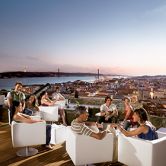
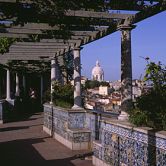
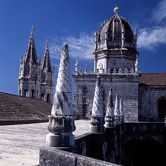


 Explore
Explore 
 Remember and Share
Remember and Share 


